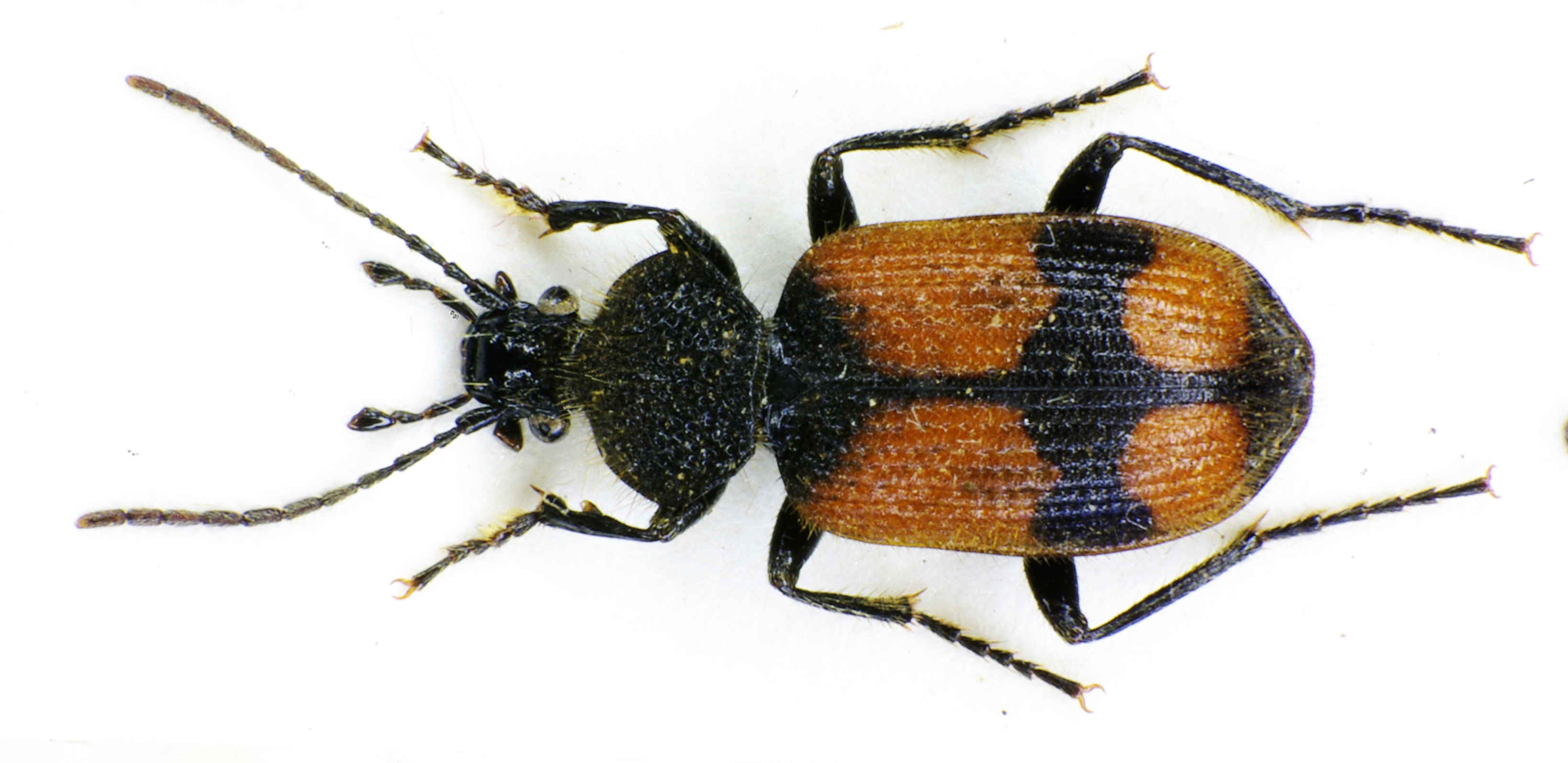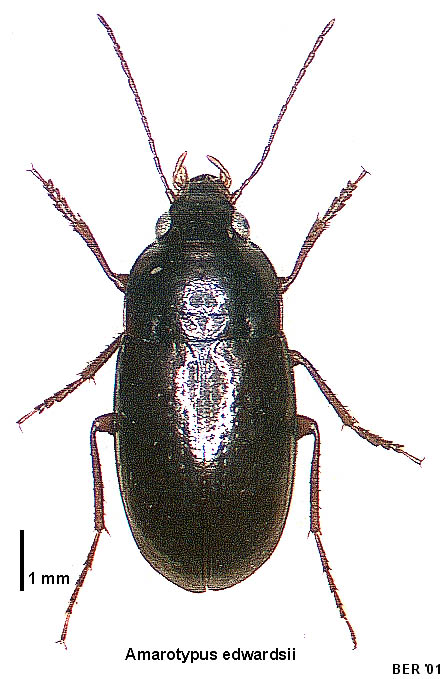|
Amarotypini
Introduction Amarotypines are a small tribe of ground beetles (Carabidae), recognised as a distinct tribe since 1985. The best known species is ''Species:Amarotypus edwardsii, Amarotypus edwardsii'' of New Zealand, widely distributed throughout the three main islands, and arboreal in habits. Biodiversity and distribution * Genus ''Amarotypus'': New Zealand (1 sp.) * Genus ''Migadopiella'': Tasmania (2 spp.) * NOTES: (1) Published taxonomic work on the tribe is currently very limited, and the presence of undescribed taxa in the South Island of New Zealand has been noted; (2) ''Species:Migadopiella, Migadopiella'' is somewhat provisionally included in Amarotypini Classification and phylogeny Previously considered to be migadopines (before 1985), amarotypines are still often treated as forming a monophyletic subfamily Migadopinae with Migadopini, but the phylogeny may be (Amarotypini, (Migadopini, Elaphrini)). Alternatively, Amarotypini may form a clade with Promecognathini, again ... [...More Info...] [...Related Items...] OR: [Wikipedia] [Google] [Baidu] |
Carabidae
Ground beetles are a large, cosmopolitan family of beetles, the Carabidae, with more than 40,000 species worldwide, around 2,000 of which are found in North America and 2,700 in Europe. As of 2015, it is one of the 10 most species-rich animal families. They belong to the Adephaga. Members of the family are primarily carnivorous, but some members are herbivorous or omnivorous. Description and ecology Although their body shapes and coloring vary somewhat, most are shiny black or metallic and have ridged wing covers ( elytra). The elytra are fused in some species, particularly the large Carabinae, rendering the beetles unable to fly. The species '' Mormolyce phyllodes'' is known as violin beetle due to their peculiarly shaped elytra. All carabids except the quite primitive flanged bombardier beetles (Paussinae) have a groove on their fore leg tibiae bearing a comb of hairs used for cleaning their antennae. Defensive secretions Typical for the ancient beetle suborder A ... [...More Info...] [...Related Items...] OR: [Wikipedia] [Google] [Baidu] |
Migadopinae
Migadopinae is a subfamily of ground beetles in the family Carabidae. There are about 18 genera and more than 40 described species in Migadopinae. Tribes These 2 tribes belong to the subfamily Migadopinae: * Amarotypini Introduction Amarotypines are a small tribe of ground beetles (Carabidae), recognised as a distinct tribe since 1985. The best known species is ''Species:Amarotypus edwardsii, Amarotypus edwardsii'' of New Zealand, widely distributed throughout t ... Erwin, 1985 (2 genera found in Australia and New Zealand) * Migadopini Chaudoir, 1861 (16 genera found in Australia, New Zealand, and South America) References Carabidae {{migadopinae-stub ... [...More Info...] [...Related Items...] OR: [Wikipedia] [Google] [Baidu] |
Genera
Genus (; : genera ) is a taxonomic rank above species and below family as used in the biological classification of living and fossil organisms as well as viruses. In binomial nomenclature, the genus name forms the first part of the binomial species name for each species within the genus. :E.g. '' Panthera leo'' (lion) and '' Panthera onca'' (jaguar) are two species within the genus '' Panthera''. ''Panthera'' is a genus within the family Felidae. The composition of a genus is determined by taxonomists. The standards for genus classification are not strictly codified, so different authorities often produce different classifications for genera. There are some general practices used, however, including the idea that a newly defined genus should fulfill these three criteria to be descriptively useful: # monophyly – all descendants of an ancestral taxon are grouped together (i.e. phylogenetic analysis should clearly demonstrate both monophyly and validity as a separate lineag ... [...More Info...] [...Related Items...] OR: [Wikipedia] [Google] [Baidu] |
Amarotypus Edwardsii
''Amarotypus'' is a genus of ground beetles in the family Carabidae. This genus has a single species, ''Amarotypus edwardsii'', found in New Zealand. Taxonomy Both the genus and species were described by English naturalist Henry Walter Bates in 1872. ''Amarotypus'' is currently a monotypic genus, however there are potentially undescribed members of the genus who live in alpine areas of New Zealand. Description ''A. edwardsii'' has well-developed hind wings, however is a flightless species. Distribution and habitat The species is found throughout New Zealand at mid and low altitudes. The species is often found in association with ''Nothofagus ''Nothofagus'', also known as the southern beeches, is a genus of 43 species of trees and shrubs native to the Southern Hemisphere, found across southern South America (Chile, Argentina) and east and southeast Australia, New Zealand, New Guin ...'' forests. References Migadopinae Monotypic Carabidae genera Beetles describe ... [...More Info...] [...Related Items...] OR: [Wikipedia] [Google] [Baidu] |
New Zealand
New Zealand () is an island country in the southwestern Pacific Ocean. It consists of two main landmasses—the North Island () and the South Island ()—and List of islands of New Zealand, over 600 smaller islands. It is the List of island countries, sixth-largest island country by area and lies east of Australia across the Tasman Sea and south of the islands of New Caledonia, Fiji, and Tonga. The Geography of New Zealand, country's varied topography and sharp mountain peaks, including the Southern Alps (), owe much to tectonic uplift and volcanic eruptions. Capital of New Zealand, New Zealand's capital city is Wellington, and its most populous city is Auckland. The islands of New Zealand were the last large habitable land to be settled by humans. Between about 1280 and 1350, Polynesians began to settle in the islands and subsequently developed a distinctive Māori culture. In 1642, the Dutch explorer Abel Tasman became the first European to sight and record New Zealand. ... [...More Info...] [...Related Items...] OR: [Wikipedia] [Google] [Baidu] |
Amarotypus
''Amarotypus'' is a genus of ground beetles in the family Carabidae. This genus has a single species, ''Amarotypus edwardsii'', found in New Zealand. Taxonomy Both the genus and species were described by English naturalist Henry Walter Bates in 1872. ''Amarotypus'' is currently a monotypic genus, however there are potentially undescribed members of the genus who live in alpine areas of New Zealand. Description ''A. edwardsii'' has well-developed hind wings, however is a flightless species. Distribution and habitat The species is found throughout New Zealand at mid and low altitudes. The species is often found in association with ''Nothofagus ''Nothofagus'', also known as the southern beeches, is a genus of 43 species of trees and shrubs native to the Southern Hemisphere, found across southern South America (Chile, Argentina) and east and southeast Australia, New Zealand, New Guin ...'' forests. References Migadopinae Monotypic Carabidae genera Beetles describe ... [...More Info...] [...Related Items...] OR: [Wikipedia] [Google] [Baidu] |
Migadopiella
''Migadopiella'' is a genus of beetles belonging to the family Carabidae Ground beetles are a large, cosmopolitan family of beetles, the Carabidae, with more than 40,000 species worldwide, around 2,000 of which are found in North America and 2,700 in Europe. As of 2015, it is one of the 10 most species-rich animal .... The species of this genus are found in Southern Australia. Species Species: *'' Migadopiella convexipennis'' *'' Migadopiella octoguttata'' References {{Taxonbar, from=Q21228520 Carabidae Carabidae genera ... [...More Info...] [...Related Items...] OR: [Wikipedia] [Google] [Baidu] |
Tasmania
Tasmania (; palawa kani: ''Lutruwita'') is an island States and territories of Australia, state of Australia. It is located to the south of the Mainland Australia, Australian mainland, and is separated from it by the Bass Strait. The state encompasses the main island of Tasmania, the List of islands by area#Islands, 26th-largest island in the world, and the List of islands of Tasmania, surrounding 1000 islands. It is Australia's smallest and least populous state, with 573,479 residents . The List of Australian capital cities, state capital and largest city is Hobart, with around 40% of the population living in the Greater Hobart area. Estimated resident population, 30 June 2017. Tasmania is the most decentralised state in Australia, with the lowest proportion of its residents living within its capital city. Tasmania's main island was first inhabited by Aboriginal Australians, Aboriginal peoples, who today generally identify as Palawa or Pakana. It is believed that Abori ... [...More Info...] [...Related Items...] OR: [Wikipedia] [Google] [Baidu] |
Migadopini
Migadopini is a tribe of ground beetles in the family Carabidae Ground beetles are a large, cosmopolitan family of beetles, the Carabidae, with more than 40,000 species worldwide, around 2,000 of which are found in North America and 2,700 in Europe. As of 2015, it is one of the 10 most species-rich animal .... There are about 16 genera and more than 40 described species in Migadopini. Genera These 16 genera belong to the tribe Migadopini: * '' Antarctonomus'' Chaudoir, 1861 (South America) * '' Aquilex'' Moret, 1989 (Ecuador) * '' Calathosoma'' Jeannel, 1938 (New Zealand) * '' Calyptogonia'' Sloane, 1920 (Australia) * '' Decogmus'' Sloane, 1915 (Australia) * '' Dendromigadops'' Baehr, 2013 (Australia) * '' Lissopterus'' G.R.Waterhouse, 1843 (South America) * '' Loxomerus'' Chaudoir, 1842 (New Zealand) * '' Migadopidius'' Jeannel, 1938 (Chile) * '' Migadops'' G.R.Waterhouse, 1842 (South America) * '' Monolobus'' Solier, 1849 (Argentina and Chile) * '' Nebriosoma' ... [...More Info...] [...Related Items...] OR: [Wikipedia] [Google] [Baidu] |



